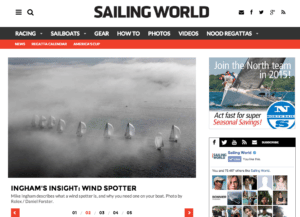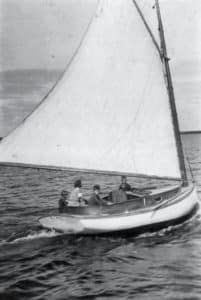
Gary Jobson 368
Sailing has numerous strengths including passionate, lifelong participants, deep-seated traditions, dedicated volunteers, established and influential yacht clubs, innovative equipment and boat manufacturers, and a strong network of organizations to somehow make it all work. In the first six months of my presidency at US SAILING (an undertaking of unimaginable proportions), I’ve reached out to sailors across the country to learn what sailing must do to attract more participants and help the sport run more easily. At a US SAILING Board of Directors’ retreat in Houston in February, and later at a “Town Hall” style session in Rhode Island in March, many ideas were put forth on how to take sailing into the future. From these sessions, it’s clear our sport continues to face many challenges.
Getting greater visibility for sailing is vitally important. The excitement and appeal of our sport seems to get lost with the overload of information that bombards all of us every day. As a sport, it’s difficult to stand out, but there are many tools available to generate more attention. The Internet is a good start to broaden our presence and entry points. US SAILING is improving its website for easy access to information for sailors and non-sailors alike. This is an ongoing process. Every sailing organization should make their website a priority; when someone curious about the sport searches “sailing” on the Internet, the virtual path should easily lead them to the real thing. One of the most compelling sailing sites for current sailors I’ve recently visited is CleverPig.org. The goal of this site is to help aspiring young sailors competing in national and international competition.
Although newspapers are struggling, I’m finding they are more open to publishing news when the right information is provided to them. Event organizers should make results available. A good start is to request a meeting with your local newspaper’s staff. At the pitch, bring pictures, sample articles, and the resumes of prominent sailors to help make your case.
Every regatta can promote itself with video reports on the web. Editing is relatively easy these days. When filming, I encourage producing quality material along with compelling interviews. This will attract more viewers and the material will be a valuable edition to a club’s archives.
The yacht club is the core institution in sailing. Many clubs are challenged with declining rosters, lower participation on the water, and aging facilities. In an effort to enhance the viability of yacht clubs, US SAILING is inviting every club in the United States to a National Yacht Club Leadership Summit. This event is scheduled for April 2 to 3, 2011, in Chicago. Speakers and panel discussions will cover many topics, including updating a mission statement, writing a long-range plan, funding a club renovation, acquiring a fleet of club-owned boats, managing junior and adult instruction, creating a signature regatta, recruiting young members, working with the local community, and many other ideas. Ted Turner is scheduled to be the keynote speaker.
Most clubs have an aging roster of members. In the United States, junior sailing is vibrant. From Opti training through collegiate sailing there is a tremendous amount of activity. But immediately after graduating, many of these sailors disappear from the sport for too long. Every yacht club should make recruiting young members a high priority. Sometimes, however, I wonder if over assertive parents and coaches are pushing many young sailors away. In recent years, there’s been too much emphasis on becoming a professional sailor, something that youth sailors are picking up on. We need to promote the Corinthian aspect of our sport instead.
In this digital age it seems that sailing should be able to develop equitable handicap rating systems. At present, boats race under several diverse rating rules in the United States, including, IRC, ORR, PHRF, and Portsmouth. Unfortunately, long distance and handicap racing is declining. Reducing the number of handicap rules and improving the fairness of rating systems would certainly help boost participation. Owners must get engaged in this process if we are to move forward.
Governmental regulation has the potential to dramatically impact sailing, and we should be more aware. There was a proposal floating around recently to require every boat to carry a transponder so it could be easily located. Sailing is about freedom: does it make sense to have Big Brother watching every time we set sail? Dredging is a big issue in many locales. We need to implement an easy permitting process. Some regattas have had difficulties getting regatta permits because anchoring race committee boats can damage the seabed, and larger race committee vessels must filter rainwater passing through their scuppers. Legal issues, insurance policies, and environmental concerns are just a few problems sailors, and racing sailors in particular, must be aware of.
Over the past 40 years, countless volunteers have upgraded race management, the measurement process, and judging. It’s fair to say that years ago race administration was inconsistent in the United States. It’s less so today, but consequently, it is increasingly difficult to certify a race officer or a judge. We need to find a way to streamline the race management process so we have quality management without driving volunteers away. Online testing is one option being developed.
Sailing events should review their course configurations, race format, and methods of management. With high-performance boats and match racing and team racing disciplines becoming popular, yacht clubs and regatta managers should survey what sailors want. A new format at events can, and will, increase participation. We seem to have too many different classes to choose from, and while it would take a lot of courage for a club to consolidate its classes, it would be beneficial in the long run. More boats on the water in fewer classes would be better.
A growth area is with community sailing programs. We need to support recreational parks and civic groups that are beginning to recognize that sailing is low impact, and is available to people of all ages and can take place in a short period of time. Of special interest is helping disabled veterans overcome their challenges through the sport of sailing. This is an area where the sailing community can provide a great service by providing water access and boating to our veterans.
US SAILING hosts 18 different national championships. Committee Chairman Steve Wrigley is leading an initiative to improve these events, some of which date back to the 1920s. There are two goals for these championships: one is to determine the best sailors in a specific discipline, and the second is to encourage participation. Wrigley’s group is reaching out to sailors across the country to participate in at least one of these events.
The United States has more sailing participation than any other country in the world, but the sport has a lower profile than in many other countries. The United States is such a vast geographic area that, in many ways, sailing here is isolated in many pockets. We could learn a lot from other countries on how they manage their sailing. American sailors who do participate overseas should write and speak about their observations. At the same time, we should all make a point to look beyond our own waters and better understand the international scene; I’m sure we can learn quite a bit that would enhance our sport, right on down to the local level.









